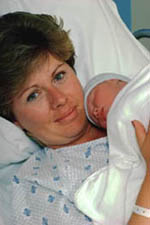Caring for the Mother: Physically and Emotionally
Postpartum care for the mother

After delivering your baby, you will continue to be watched and get pain relief, if needed. You and your baby usually stay at the hospital for a couple of days to recover.
What does recovering from childbirth involve?
As you recover, the following symptoms are not uncommon:
Bloody vaginal discharge that changes to brown, then whitish over the next few weeks after delivery
A tender vaginal area
Painful contractions that may continue after delivery. These happen as the uterus returns to its original size.
Breast engorgement as you begin to produce breastmilk
Fatigue and soreness. These are common in the first few weeks.
It is generally recommended that you schedule an appointment with your healthcare provider 6 weeks after delivery to make sure of proper healing.
The first few weeks as a mother
During the first few weeks, you need to take good care of yourself to rebuild your strength. The following steps can help:
Take naps when the baby naps, to make up for lost sleep at night from getting up to feed the baby.
Wear a supportive bra. Cold packs may help relieve breast engorgement and swelling. Warm compresses can be used to help stimulate the letdown of milk. Letdown is a reflex that triggers the release of breastmilk. If you choose not to breastfeed, use ice packs and bind your breasts for several days to help ease engorgement.
If stitches were needed during a vaginal delivery, take warm, shallow baths (sitz baths) twice a day to ease soreness and speed healing.
After a cesarean section, keep the incision clean and dry.
What are the "baby blues"?
It is not uncommon to have the "baby blues" during the first days or weeks after delivery. They are most often happen suddenly on the third or fourth day after delivery. The "baby blues" have the following symptoms, although each woman may have slightly different symptoms:
Feelings of disappointment
Crying with no known reason
Irritability
Impatience
Anxiety
Restlessness
It is common for these "baby blues" feelings to go away soon after they start and usually without treatment. These symptoms may also be present in postpartum depression. Postpartum depression is a more severe form of baby blues. Women with postpartum depression may have trouble coping with their daily tasks.
What is postpartum depression?
Postpartum depression is much more serious and lasting than the "baby blues." The following are the most common symptoms of postpartum depression. But each woman may have slightly different symptoms. Symptoms may include:
Sadness
Anxiety
Hopelessness
Fatigue or exhaustion
Poor concentration
Confusion
A fear of harming the newborn or yourself
Mood swings with exaggerated highs, lows, or both
Lower sex drive (libido)
Feelings of guilt
Low self-esteem
Uncontrolled crying and with no known cause
Overconcern for or overattentiveness of the newborn, or a lack of interest in the newborn
Appetite changes
Sleep disturbances
Resentment
Memory loss
Feelings of isolation
What causes postpartum depression?
While the exact cause for postpartum depression is unknown, it is likely that a number of different things are involved. These may include:
The changing of roles (as a spouse and new parent)
Hormone changes during and after delivery
Stress
Personal or family history of mental illness, particularly postpartum depression
Marital strife
How is postpartum depression diagnosed?
Typical diagnostic procedures for postpartum depression include a complete health history, physical exam, and/or psychiatric evaluation. In some cases, you may need a thyroid screening to find any hormone or metabolic problems or conditions that may serve as an underlying cause.
Treatment for postpartum depression
It is important to note that most women who get the "baby blues," postpartum depression, postpartum anxiety, or postpartum obsessive-compulsive disorder have never had these symptoms before, especially with such intensity. In any case, it is important to get proper treatment early. This is not only to make sure that the newborn remains safe and properly cared for, but also so that you can resolve these symptoms and experience all the joys of motherhood.
Specific treatment for postpartum depression will be determined by your healthcare provider based on:
Your age, overall health, and health history
How serious your symptoms are and how long they have lasted
Whether you are breastfeeding
Your tolerance for specific medicines, procedures, or therapies
Your opinion or preference
Treatment may include:
Medicine such as hormone treatments, antidepressants, or both
Psychological treatment. This may include both you and your family or partner.
Peer support such as support groups and educational classes
Stress management and relaxation training
Exercise
Assertiveness training. Some women need to learn how to set limits with family members in order that they do not become overwhelmed and overworked.
Connect with us:
Download our App: